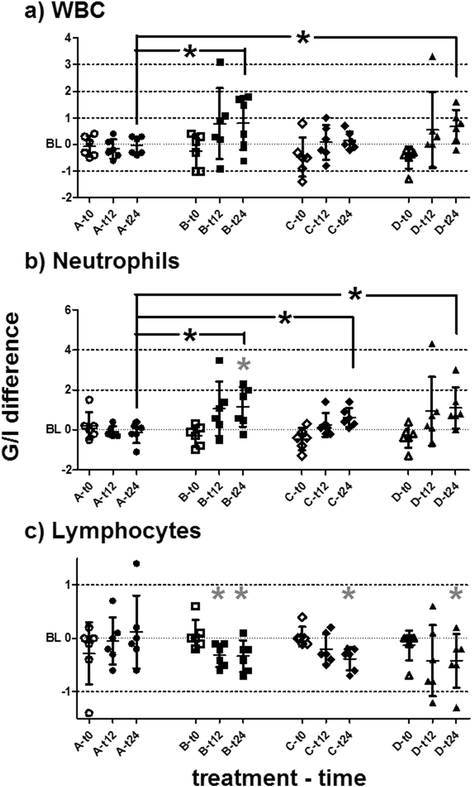Immune response of healthy horses to DNA constructs formulated with a cationic lipid transfection reagent
- PMID: 26100265
- PMCID: PMC4476236
- DOI: 10.1186/s12917-015-0452-3
Immune response of healthy horses to DNA constructs formulated with a cationic lipid transfection reagent
Abstract
Background: Deoxyribonucleic acid (DNA) vaccines are used for experimental immunotherapy of equine melanoma. The injection of complexed linear DNA encoding interleukin (IL)-12/IL-18 induced partial tumour remission in a clinical study including 27 grey horses. To date, the detailed mechanism of the anti-tumour effect of this treatment is unknown.
Results: In the present study, the clinical and cellular responses of 24 healthy horses were monitored over 72 h after simultaneous intradermal and intramuscular application of equine IL-12/IL-18 DNA (complexed with a transfection reagent) or comparative substances (transfection reagent only, nonsense DNA, nonsense DNA depleted of CG). Although the strongest effect was observed in horses treated with expressing DNA, horses in all groups treated with DNA showed systemic responses. In these horses treated with DNA, rectal temperatures were elevated after treatment and serum amyloid A increased. Total leukocyte and neutrophil counts increased, while lymphocyte numbers decreased. The secretion of tumour necrosis factor alpha (TNFα) and interferon gamma (IFNγ) from peripheral mononuclear blood cells ex vivo increased after treatments with DNA, while IL-10 secretion decreased. Horses treated with DNA had significantly higher myeloid cell numbers and chemokine (C-X-C motif) ligand (CXCL)-10 expression in skin samples at the intradermal injection sites compared to horses treated with transfection reagent only, suggesting an inflammatory response to DNA treatment. In horses treated with expressing DNA, however, local CXCL-10 expression was highest and immunohistochemistry revealed more intradermal IL-12-positive cells when compared to the other treatment groups. In contrast to non-grey horses, grey horses showed fewer effects of DNA treatments on blood lymphocyte counts, TNFα secretion and myeloid cell infiltration in the dermis.
Conclusion: Treatment with complexed linear DNA constructs induced an inflammatory response independent of the coding sequence and of CG motif content. Expressing IL-12/IL-18 DNA locally induces expression of the downstream mediator CXCL-10. The grey horses included appeared to display an attenuated immune response to DNA treatment, although grey horses bearing melanoma responded to this treatment with moderate tumour remission in a preceding study. Whether the different immunological reactivity compared to other horses may contributes to the melanoma susceptibility of grey horses remains to be elucidated.
Figures








Similar articles
-
Local and systemic effect of transfection-reagent formulated DNA vectors on equine melanoma.BMC Vet Res. 2015 May 14;11:107. doi: 10.1186/s12917-015-0414-9. BMC Vet Res. 2015. PMID: 25967290 Free PMC article. Clinical Trial.
-
Local and systemic effect of transfection-reagent formulated DNA vectors on equine melanoma.BMC Vet Res. 2015 Jun 11;11:132. doi: 10.1186/s12917-015-0422-9. BMC Vet Res. 2015. PMID: 26063232 Free PMC article.
-
In vivo induction of interferon gamma expression in grey horses with metastatic melanoma resulting from direct injection of plasmid DNA coding for equine interleukin 12.Schweiz Arch Tierheilkd. 2011 Nov;153(11):509-13. doi: 10.1024/0036-7281/a000262. Schweiz Arch Tierheilkd. 2011. PMID: 22045456
-
The role of regulatory T lymphocytes in the induced immune response mediated by biological vaccines.Immunobiology. 2006;211(1-2):127-36. doi: 10.1016/j.imbio.2005.11.003. Epub 2006 Jan 4. Immunobiology. 2006. PMID: 16446177 Review.
-
Review: dendritic cell immunotherapy for melanoma.Cancer Biother Radiopharm. 1999 Feb;14(1):11-22. doi: 10.1089/cbr.1999.14.11. Cancer Biother Radiopharm. 1999. PMID: 10850282 Review.
Cited by
-
Antitumor Activities of Interleukin-12 in Melanoma.Cancers (Basel). 2022 Nov 14;14(22):5592. doi: 10.3390/cancers14225592. Cancers (Basel). 2022. PMID: 36428682 Free PMC article. Review.
References
-
- Cavalleri JMV, Mählmann K, Steinig P, Feige K. Aetiology, clinical presentation and current treatment options of equine malignant melanoma - a review of the literature. Pferdeheilkunde. 2014;30(4):455–60.
-
- Mcfadyean J. Equine melanomatosis. J Comp Path Ther. 1933;46:186–204. doi: 10.1016/S0368-1742(33)80025-7. - DOI
Publication types
MeSH terms
Substances
LinkOut - more resources
Full Text Sources
Other Literature Sources
Medical

